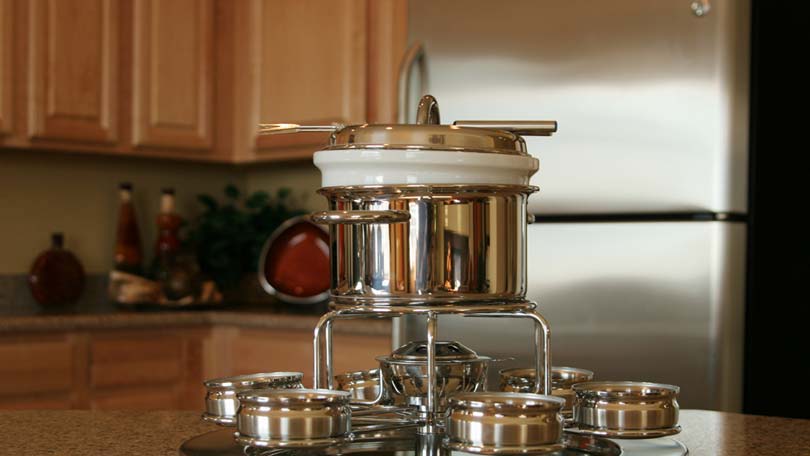Fondue, a warm cheese dish that dates back to the 18th century, originated in Switzerland, more specifically in the Canton of Neuchatel, at a time when both cheese and wine were important industries in that part of the world. This dish consists of at least two varieties of cheeses that are melted with wine and a bit of flour and served communally out of an earthenware pot called a “caquelon.” When the pot was placed over a separate burner or a tea candle that kept the cheese warm and in a liquid state, family members and guests would sit around the table sharing the creamy concoction by dipping cubes of bread that had been speared on the end of long forks.
This simple-to-prepare meal utilized ingredients that were found in most average homes, and was invented out of necessity when villagers living in remote mountain areas found it difficult to replace fresh food that became scarce during the winter months. The Swiss found that even cheese that had passed its prime could be made not only edible, but also delicious due to the blending and melting process. When local wines and seasonings were added, even stale bread tasted scrumptious after it was swirled in the creamy melted cheese.
Etiquette
Because fondue is a communal meal, it seems somewhat logical that participants adhere to a few basic rules of thumb. Be they practical or humorous, in order to facilitate a pleasant dining experience, the general guidelines are as follows: Spear a piece of bread on the end of your fondue fork and dip it into the pot, then twirl the bread cube gently in the cheese until thoroughly coated. It is best to let the bread drip before putting it in your mouth, which will allow the excess to dribble back into the pot and afford time for cooling. It is considered bad form to touch the fork with your lips or tongue because the fork does go back in the pot. Avoid double dipping at all times.
The Swiss Tradition
Most recipes we see for traditional Swiss style fondue are a combination of two cheeses, Gruyere and Emmenthaler. These two cheeses are combined because either cheese alone would taste too sharp or too bland. The cheeses are most commonly melted in a dry white wine. Kirsch (a clear cherry brandy) is added if the cheese itself is too young to produce the desired tartness.
Each canton in Switzerland has their own “traditional” style fondue, such as:
- Fribourg: The fondue from this region combines Gruyere with Vacherin a Fondue. The wine and Kirsch is only added if the cheese is not fully ripened. When the wine is not used, guests dip their bread in plum schnapps, then into the fondue.
- Geneva: Geneva uses three cheeses, Gruyere, Emmental and Walliser Bergkase. A regional addition may include chopped morel mushrooms.
- Glarus: First a roux is made of butter, flour, and milk, then Gruyere and Schabzieger cheeses are added.
- Eastern Switzerland: Appenzeller and Vacherin a Fondue are the cheeses of choice combined with a dry cider.
- Vaud: The locals roast and chop garlic then combine with Gruyere cheese.
- Neuchatel: A combination of two thirds Gruyere and one third Emmental, or a half and half version with Neuchatel wine.
- French Fondues: Fondue Savoyarde: comte savoyard, beaufort, and emmental. Fondue Jurassienne: pure mature and normal comte
- Italian Fondue: Fonduta: is prepared in the French-minority region of Aosta valley in Italy, and uses fontina, milk, eggs, and truffles.
The perfect Fondue:
In what is considered a perfect cheese fondue, the mixture is held at a temperature low enough to prevent burning, but hot enough to keep the fondue smooth and liquid. Ideally, when the fondue is finished, there will be a thin crust of toasted, but not burnt cheese in the bottom of the caquelon. In French, this is commonly referred to as ‘la religieuse’ (the nun).
Bread:
When choosing the consummate bread to accompany the fondue, crusty French or Italian style bread will do, but a baguette works very well. When slicing the bread, it is best to make sure that each piece includes some of the crust, which will help to keep the bread on the fork when it is dipped into the cheese.
Renewed Interest:
Once it was a popular form of entertaining in the 1950s and 1960s, and now fondue is currently making a significant comeback. Streamlined fondue sets and beautifully revived traditional units can be found on the shelves and websites of cookware stores. Apparently, a brand-new generation has suddenly discovered that fondue is a delicious, intimate, and easy way to entertain friends and family.






